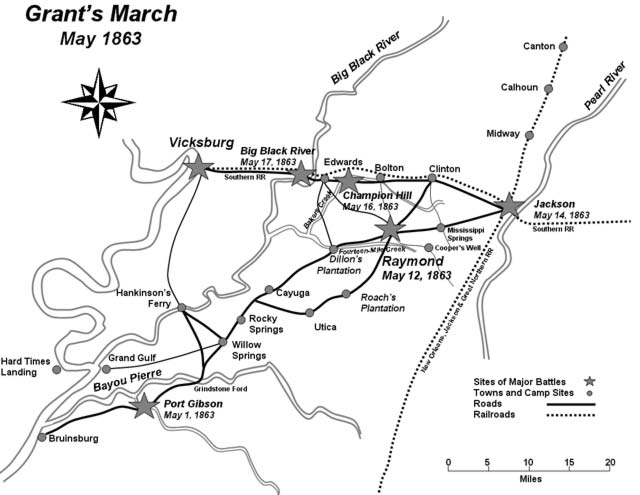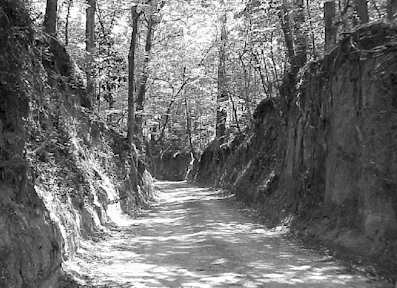|
Grant's March "Indeed, it was nothing but a great game of chess
that was being played,
On the 27th McClernand’s corps was all at Hard Times, and McPherson’s was following closely. I had determined to make the attempt to effect a landing on the east side of the river as soon as possible. Accordingly, on the morning of the 29th, McClernand was directed to embark all the troops from his corps that our transports and barges could carry. About 10,000 men were so embarked. The plan was to have the navy silence the guns at Grand Gulf, and to have as many men as possible ready to debark in the shortest possible time under cover of the fire of the navy and carry the works by storm. Sherman had not left his position above Vicksburg yet. On the morning of the 27th I ordered him to create a diversion by moving his corps up the Yazoo and threatening an attack on Haines’ Bluff. My object was to compel Pemberton to keep as much force about Vicksburg as I could, until I could secure a good footing on high land east of the river. The move was eminently successful and, as we afterwards learned, created great confusion about Vicksburg and doubts about our real design. Sherman moved the day of our attack on Grand Gulf, the 29th, with ten regiments of his command and eight gunboats which Porter had left above Vicksburg. . Landing at Bruinsburg The embarkation below Grand Gulf took place at De Shroon’s, Louisiana, six miles above Bruinsburg, Mississippi. Early on the morning of 30th of April McClernand’s corps and one division of McPherson’s corps were speedily landed. When this was effected I felt a degree of relief scarcely ever equalled since. Vicksburg was not yet taken it is true, nor were its defenders demoralized by any of our previous moves. I was now in the enemy’s country, with a vast river and the stronghold of Vicksburg between me and my base of supplies. But I was on dry ground on the same side of the river with the enemy. All the campaigns, labors, hardships and exposures from the month of December previous to this time that had been made and endured, were for the accomplishment of this one object.
I had with me the 13th corps, General McClernand commanding, and two brigades of Logan’s division of the 17th corps, General McPherson commanding—in all not more than twenty thousand men to commence the campaign with. These were soon reinforced by the remaining brigade of Logan’s division and Crocker’s division of the 17th corps. On the 7th of May I was further reinforced by Sherman with two divisions of his, the 15th corps. My total force was then about thirty-three thousand men. The enemy occupied Grand Gulf, Haines’ Bluff and Jackson with a force of nearly sixty thousand men. Jackson is fifty miles east of Vicksburg and is connected with it by a railroad. My first problem was to capture Grand Gulf to use as a base. McClernand was advanced as soon as ammunition and two days’ rations (to last five) could be issued to his men. The bluffs were reached an hour before sunset and McClernand was pushed on, hoping to reach Port Gibson and save the bridge spanning the Bayou Pierre before the enemy could get there; for crossing a stream in the presence of an enemy is always difficult. Port Gibson, too, is the starting point of roads to Grand Gulf, Vicksburg and Jackson. The Road to Raymond During the night of the 6th McPherson drew in his troops north of the Big Black and was off at an early hour on the road to Jackson, via Rocky Springs, Utica and Raymond. That night he and McClernand were both at Rocky Springs ten miles from Hankinson’s ferry. McPherson remained there during the 8th, while McClernand moved to Big Sandy and Sherman marched from Grand Gulf to Hankinson’s ferry. The 9th, McPherson moved to a point within a few miles west of Utica; McClernand and Sherman remained where they were. On the 10th McPherson moved to Utica, Sherman to Big Sandy; McClernand was still at Big Sandy. The 11th, McClernand was at Five Mile Creek; Sherman at Auburn; McPherson five miles advanced from Utica. May 12th, McClernand was at Fourteen Mile Creek; Sherman at Fourteen Mile Creek; McPherson at Raymond after a battle. After McPherson crossed the Big Black at Hankinson’s ferry Vicksburg could have been approached and besieged by the south side. It is not probable, however, that Pemberton would have permitted a close besiegement. The broken nature of the ground would have enabled him to hold a strong defensible line from the river south of the city to the Big Black, retaining possession of the railroad back to that point. It was my plan, therefore, to get to the railroad east of Vicksburg, and approach from that direction. Accordingly, McPherson’s troops that had crossed the Big Black were withdrawn and the movement east to Jackson commenced.
As has been stated before, the country is very much broken and the roads generally confined to the tops of the hills. The troops were moved one (sometimes two) corps at a time to reach designated points out parallel to the railroad and only from six to ten miles from it. McClernand’s corps was kept with its left flank on the Big Black guarding all the crossings. Fourteen Mile Creek, a stream substantially parallel with the railroad, was reached and crossings effected by McClernand and Sherman with slight loss. McPherson was to the right of Sherman, extending to Raymond. The cavalry was used in this advance in reconnoitering to find the roads: to cover our advances and to find the most practicable routes from one command to another so they could support each other in case of an attack. In making this move I estimated Pemberton’s movable force at Vicksburg at about eighteen thousand men, with smaller forces at Haines’ Bluff and Jackson. It would not be possible for Pemberton to attack me with all his troops at one place, and I determined to throw my army between his and fight him in detail. This was done with success, but I found afterwards that I had entirely under-estimated Pemberton’s strength. Up to this point our movements had been made without serious opposition. My line was now nearly parallel with the Jackson and Vicksburg railroad and about seven miles south of it. The right was at Raymond eighteen miles from Jackson, McPherson commanding; Sherman in the centre on Fourteen Mile Creek, his advance thrown across; McClernand to the left, also on Fourteen Mile Creek, advance across, and his pickets within two miles of Edward’s station, where the enemy had concentrated a considerable force and where they undoubtedly expected us to attack. McClernand’s left was on the Big Black. In all our moves, up to this time, the left had hugged the Big Black closely, and all the ferries had been guarded to prevent the enemy throwing a force on our rear. Links Old Port Gibson Road: Civil War Route to Raymond |
||
| | Home | Grant's March
| Gregg's March | Battle
of Raymond | Order of Battle | Commanders | Soldiers
Who Fought | Diaries & Accounts
| | Official Records | Confederate Cemetery | Kaleidoscope of History | Re-enactments | Battlefield Preservation | Bookstore | Visitors | Copyright (c) James and Rebecca Drake, 1998 - 2002. All Rights Reserved. |


